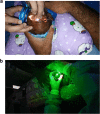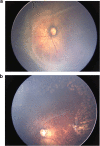Retinopathy of prematurity treatment: Asian perspectives
- PMID: 31664193
- PMCID: PMC7093470
- DOI: 10.1038/s41433-019-0643-4
Retinopathy of prematurity treatment: Asian perspectives
Abstract
Retinopathy of prematurity (ROP) is a vasoproliferative disease of developing retinal vessels that affects premature infants and can lead to severe and irreversible visual loss if left untreated. India and some other Asian countries are in the middle of a 'third ROP epidemic'. Blindness due to ROP is largely preventable if appropriate, adequate and accessible screening programmes are available. Screening of the premature babies is the first step in ROP management. With the increase in use of tele-screening techniques, more premature babies have been brought under the screening network both from urban and rural regions. Laser photocoagulation to the avascular retina using indirect ophthalmoscopy delivery system is the gold standard for ROP treatment and is usually done under topical anaesthesia in the Asian region in contrast to the western world. Use of intravitreal anti-vascular endothelial growth factors (VEGF) although controversial in management of ROP has been found to be effective in various Asian studies as well. ROP surgery in India and other middle-income Asian countries is largely performed only in few tertiary eye care centres. Poor visual prognosis, late presentation with advanced retinal detachments, lack of adequate number of trained paediatric retinal surgeons and paediatric anaesthetists also contribute to this problem. This current paper summarizes the Asian experience of ROP management.
早产儿视网膜病变的治疗: 在亚洲的展望: 早产儿视网膜病变 (ROP) 是一种影响早产儿视网膜血管发育的血管增生性疾病, 不加以干预会导致严重且不可逆的视力丧失。如今印度和其他一些亚洲国家正处于“第三次ROP流行”的中期。ROP所致的失明大多数可通过适当、到位的和可及的筛查计划的实施进行预防。筛查早产儿是ROP管理的第一步。随着远程筛查技术应用的增加, 越来越多的早产儿已被纳入了城市及农村地区的筛查网络。相较于西方国家, 在亚洲多使用表麻下间接检眼镜传输系统对无血管区的视网膜进行激光光凝作为治疗ROP的金标准。玻璃体腔内注射抗血管内皮生长因子 (VEGF) 虽然在ROP的治疗上有争议, 但在众多亚洲研究中被认为是有效的。印度和其他中等收入的亚洲国家ROP手术大多数只在少数的三级眼科治疗中心进行。视力预后差, 视网膜脱离严重时才就诊, 缺乏足够数量训练有素的儿童视网膜外科医生和儿童麻醉师也造成了这个问题。本文总结了亚洲在ROP管理方面的经验。.
Conflict of interest statement
The authors declare no conflict of interest.
Figures



References
-
- World Health Organization. Born too soon: the global action report on preterm birth. World Health Organization. http://www.who.int/pmnch/media/news/2012/201204_borntoosoon-report.pdf. (News release dated 2 May 2012).
-
- Blencowe H, Cousens S, Oestergaard MZ, Chou D, Moller AB, Narwal R, et al. National, regional, and worldwide estimates of preterm birth rates in the year 2010 with time trends since 1990 for selected countries: a systematic analysis and implications. Lancet. 2012;379:2162–72. - PubMed
-
- Cross CW. Cost of preventing retrolental fibroplasia. Lancet. 1973;2:954–6. - PubMed
Publication types
MeSH terms
LinkOut - more resources
Full Text Sources
Medical

